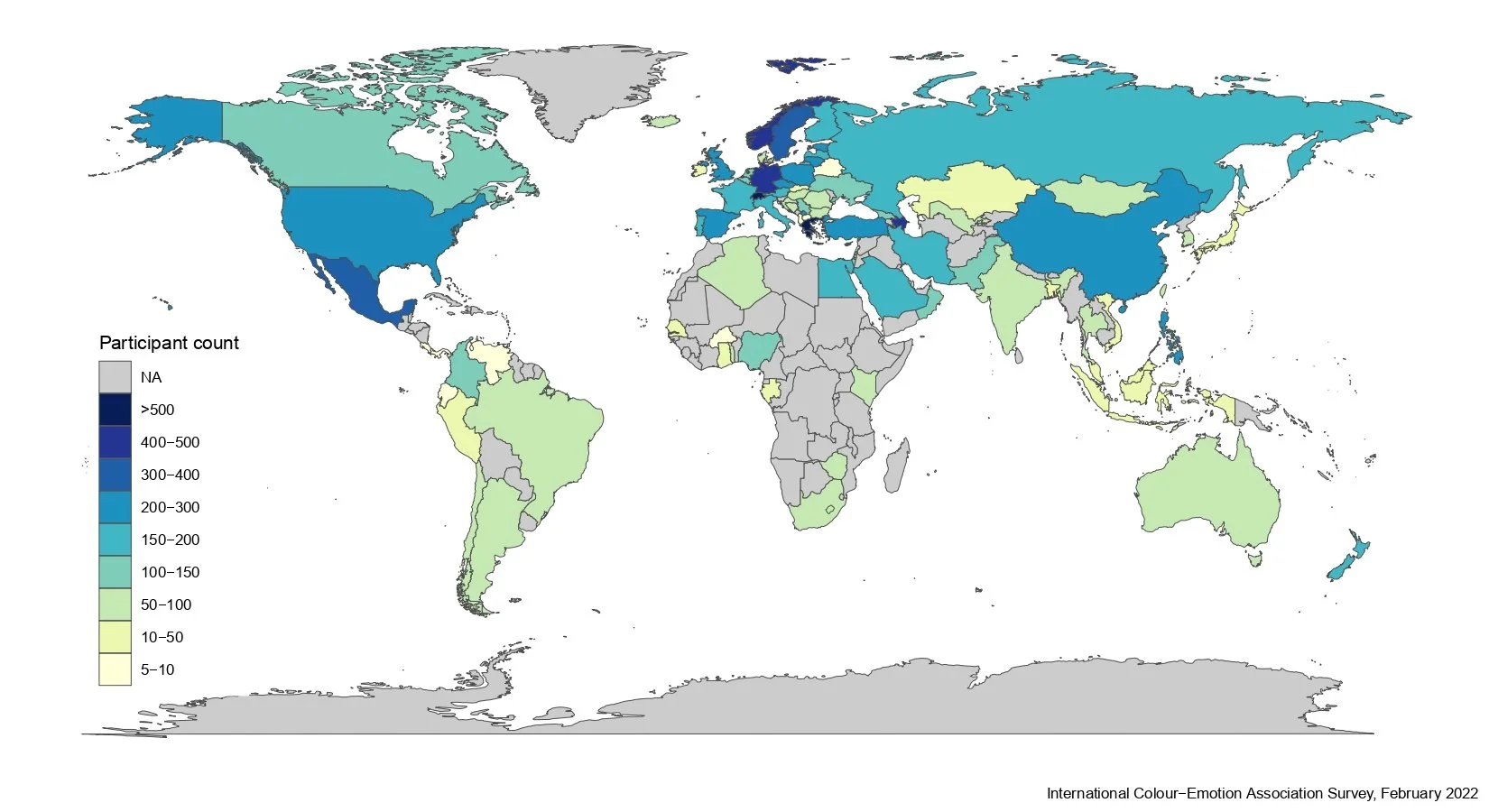Feel the Colour! Assesing the impact of colour and ambient coloured light on human emotions.
Does being immersed in colour impact our emotions?
In everyday life, we have to decide upon colours of objects we surround ourselves with. Whether it is choosing the wall colours of our apartment, deciding what to wear, or choosing the brand of butter from the shelf in a supermarket - colour is an important feature, which may guide us in making these decisions.
In our research, we use Virtual Reality (VR) and ambient light technologies to immerse participants in coloured settings. We test their emotional responses physiologically and psychologically to find out whether colours can impact our emotions.
This project has been funded with the Swiss National Science Foundation Ambizione fellowship grant.
International Colour-Emotion Association Survey
You can see on this map how many people from each country have so far participated (as of February 2022). Bluer colours indicate more participants.
Which emotions do you associate with colours?
We often use colours and colour names to communicate about emotions (e.g. “I feel blue”). In collaboration with over a hundred researchers worldwide, we are running large international studies on colour-emotion association. We test if people agree with each other and to what extent our cultural background determines how we assign emotional meanings to colours.
Ready to participate? Click here and select your native language.
Want to access data? Click here and cite this article.
Favourite and Least Favourite Colours
What you can see here is the starting screen of the colour selection tool
what colour do you like and why?
Sometimes, we would like to find a colour that cannot be captured by words. Our colour research team together with Prof. C. Alejandro Parraga at the Autonomous University of Barcelona have developed an online colour selection tool that helps to find the best match. This intuitive user-friendly tool allows you to quickly visualise any colour that you can imagine and produce on screen.
Most frequently, we use this tool to assess what colours people like and dislike. Understanding colour preferences provides a window to people’s aesthetic experiences with colours, while understanding why certain colours are liked or disliked, helps making predictions.
Check the colour picker here.
Colour-Affect Relationships in the Colour-Blind, the Blind and the Sighted
The two images contrast how the environment (left image) is seen through the eyes of a person with red-green blindness (right image).
Do colours convey affective meaning of what we see?
We investigate the importance of visual experience in two lines of research, by studying i) colour-blind and ii) blind individuals. Colour-blind individuals have a limited ability to see the full colour range, most frequently limited in the red-green range. Totally blind individuals cannot see any colours at all. Those who became blind later in life had experienced colours and potentially can mentally imagine them, while those who are blind from birth can only think about colours in abstract terms.
In collaboration with Hilfsgemeinschaft, we investigate how reduced colour vision affects how we interpret our environment and its affective meaning.
This research is supported by the Swiss National Science Foundation with Doc.CH (colour-blind) and Postdoc.Mobility (totally blind) fellowship grants.
Beyond the Student Population: Involving Local Communities in Colour Research
Community testing with Quartiers Solidaires and ProSenectute (copyright Dominique Schluechter, Nele Dael and Elena Arbona Cuesta)
An evidence-based approach to understand the meaning of colour in different populations
We like moving our laboratory outside academic walls to engage with different communities. We foster evidence-based knowledge tailored to specific life situations or age groups (older people, inpatients, families, children in day-care or schools, prisoners, etc.). This project aims to boost awareness in the general public and offer a scientific angle in understanding the potential impact of our emotions, beliefs and preferences on everyday colour decisions. Testing different populations helps us to further validate our research findings and discover the effects of age and community, culture, or environment on how we think and feel about colour.
This research is supported by the Swiss National Science Foundation project grant.
The Role of Colour and Emotion in the Context of Art
On the left, you see one of over 2000 self-portraits by A. Henrion (copyright The Helmut Klewan Collection, Belvedere Museum, Vienna). We tested which of 20 emotions best represent the depicted facial expression.
Does colour influence how we feel about art?
Visual artists and the living arts use colour in their creations, often with an aim to deliver a certain emotional experience. An artist might consciously or sub-consciously choose colours that represent or evoke certain emotions.
In this line of research, we are investigating what emotions people perceive in art, and to what extent colour contributes to this experience. This research is supported by the Swiss National Science Foundation Postdoc.Mobility fellowship grant.
Matching colour to internal states and traits
What is the evidence that your chosen colour represents who you are, or vice versa, can a colour represent what personality measures assess?
Can colour choices tell who you are and what you feel?
Popular media suggests that colour choices reflect one’s feelings or personality. For example, red colour is assumed to represent a colour of activity and anger, thus it must appeal to energetic people. We are collecting evidence allowing us to empirically test such claims by using various types of affect assessment methods (self-report, emotion induction) and personality assessment methods as well as different colour measurement techniques (e.g. colour selection tool).







